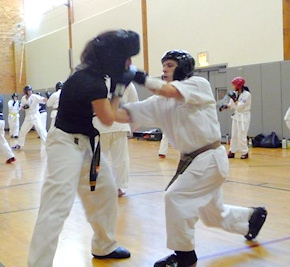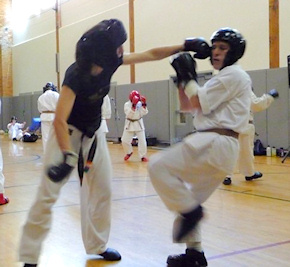2020 February
2018 December August June February
2017 December September June March
2016 November August June March
2015 December October July May February
2014 December October July April February
2013 December October August May February
2012 December September July April February
2011 December September July April February
from the December, 2014 issue of Kiai!
10 and 20 Years in the Art:
A Conversation between Sensei Katherine
and Senpai Ryan
By Senpai Ryan Libel
2nd degree black belt and TW Director of Operations
About six months ago, Sensei Katherine Nichols, editor-in-chief of this newsletter, and I were discussing Kiai! article possibilities. I mentioned an interest in writing something about 2014 being my 10th anniversary of training at Thousand Waves, and as we talked about the idea, she mentioned that 2014 also happens to be her own 20th anniversary of training. So a few weeks back we booked an hour on a Friday afternoon to sit down and reminisce about our decade and two in the art.

Point!
KN: Well for me, the longer I’ve trained, the more involved I’ve become at Thousand Waves. I started as an ordinary training member who pitched in when help was needed. Then, when I was a brown belt I decided to volunteer my graphic art skills for various projects, including Kiai! when it began as a paper publication in 1999. That kept me busy for quite awhile, and it wasn’t until I was fairly senior in rank – right before my sandan [third degree black belt] test in 2007– that I started teaching, with one class a week in the Youth program. I gradually added more and more classes, and then a couple of years ago you all asked me to come on staff to fill some gaps in administration.
RL: I remember thinking I was pretty involved from about yellow belt on – I took a writing assignment to chronicle a period of TW’s history on the occasion of our 20th anniversary back in 2005, then I started assisting in the Self-Defense program after doing a little research for former VP program head, Marie O’Brien on bullying – I think I was a green belt at that time. I joined the board of directors a couple of years after that. I became a self-defense instructor shortly after earning my shodan [first degree black belt], and was approached by the Shihans about joining the staff around that same time, close to 5 years ago.
KN: And of course I trained in the old space next door that was shared with the spa, before men began training with us. I tested for blue and yellow belt there, before we moved here in early ’96. I think that’s one of the greatest things about training in a community for so long – you become a holder of a lot of institutional memory.

Counterpoint!
KN: Well, for example, something newer members might not know about: there was a place for men who wanted to learn Seido Karate back then in the 90s. They went to Sensei Laura Tesch's dojo, Chicago Seido Karate. One other thing about that time – there was a real focus on Thousand Waves as a place where people come to heal. I know that was a significant part of my early path, and it has sustained me to this day. Sei Shihan Nancy’s new self-defense fighting skills class on Wednesdays is reconnecting me with healing through fighting. All along, the support from the community and just the physical training have been anchors in my life.
RL: Yes, I hope we all definitely still feel that here, I know I do. Also, there’s healing and there’s longevity. I’ve referred to Seido karate as the “Fountain of Youth” – we’ve got people training into their 60s, 70s – here I sit only pushing 40, and I still feel my karate skills are on an upward trajectory, but in my running, my other primary physical pursuit, I’m afraid I can no longer say that!
KN: I’ve been lucky never to have any serious injuries, which is probably one reason I’ve stuck around so long. Even so, I trained with such gusto at 32 when I started, and now, at 52, it’s a little different.
RL: You’ve sure still got the gusto, at least when I spar you! It’s nice to have new things come along and stimulate you after two decades too. Some more philosophical concerns have been with me since the beginning, and I never seem to tire of wrestling with them – the contradiction between viewing myself as something close to a pacifist, and practicing a fighting art, for example.
KN: People write about that at promotion to brown belt. On that subject, I think about the way my view of power has changed over time. At first for me karate was about being strong – punch hard/kick hard, be STRONG. After you train for a bit you learn takedowns – how to use someone else’s power, turning their own energy against them, right? We learn to use our partner's power against them, and then to blend our power with them in our physical practice. We manifest our knowledge of power as teachers of the martial arts. This progression has parallels in our interpersonal practice – giving us the power to change things in the world.
RL: Yes, karate for me has been instrumental in helping me with some of my longstanding issues with authority. We get out there on the training floor and acknowledge the path of those who have gone before, both our teachers and students more senior to us. We say “Osu” and swallow our objection to a piece of feedback, almost always realizing a few moments later that we needed it. We let go of mistakes our partners make by assuming their best intentions. There’s nothing like sparring to make you wrestle with your ego!
KN: Yes, some of those ideas are embedded in the code of ethics we focus on with the kids, right – respect? I’m thinking a lot about meditation, too. Meditation has many manifestations in our training – sitting weekly, and before & after class of course, but also the idea of moving Zen in our physical training. I’ve come to think of meditation as being whatever you do in a meditative manner.
RL: I know you think a lot about meditation – I’ve noticed you’ve always been about the most stalwart presence in the TW weekly meditation circle outside of the Shihans! Sakyong Mipham, the head of Shambhala community, says that meditation is its own thing, that if you’re doing something else you’re not really meditating. Sei Shihan Nancy and Jun Shihan Sarah gave me his book, Running with the Mind of Meditation a couple years back. He’s a major marathon runner, and he says that he’s not meditating while running, but his running is informed by his meditation. I don’t quite see it that way myself – my running, my karate, both can definitely be moving meditation for me. I sure don’t want to quarrel with the Saphyong, though!
KN: Well I will quarrel with the Saphyong, because I don't follow him! He is one guy who has put forward his opinion. In the end, it's your life and how you live it. In my life, practicing karate, practicing my guitar, my morning exercises and walks by the Lake, even playing my silly computer games at the end of the day – all feel like meditation to me. All help calm the active mind.
RL: It’s about putting some space in between a stimulus and a response – learning to ACT, not REACT.
KN: Don’t you think that manifests itself in some of our ideas about activism and social justice? Meditation helping us channel energy?
RL: It certainly has for me – I don’t have a daily isolated meditation practice, but like you I seek those benefits in a few ways. I hope that I’m more focused now on what we can do to move forward than my older way of simply yelling about society’s problems – that’s something I think my karate has helped me with. In a way what I’m trying to say goes back to respecting others, back to thinking about sparring again, for example. Sparring helps us see ourselves and others with all our strengths and weaknesses, it has a way of humanizing us, of increasing our empathy for our fellow humans. Kaicho [Seido founder and Grandmaster] also talks a lot about karate as a mirror that helps us see ourselves more clearly.
KN: And there’s always more to learn, we keep coming back to the same ideas, after 10 years, after 20 years, and, hopefully, after 30.
RL: Yes, that’s a huge part of it for me, lifelong learning, as is belonging to this Thousand Waves community. By the way I can’t tell you how much I loved, after knowing you for these many years, meeting a few of your family members at our Art with Heart performance back in July. Meeting people’s families is huge for me – at their promotion tests and on other occasions; you really see a side of a person you can’t know otherwise.
KN: Time always flies – it’s about time for me to get into a gi and teach the kids.
RL: I’m so glad we did this – we should chat like this more often.
